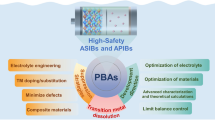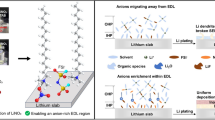Abstract
Lithium difluoro(oxalate)borate (LiODFB) is acknowledged as a new type of electrolyte lithium salt with great potential for high-voltage lithium-ion batteries. Utilizing Raman spectroscopy, a conductivity tester, and a viscometer, this study concentrates on the solution structures and properties of LiODFB-solvent systems. The results demonstrated that in the sulfolane (SL) solvent, the main coordination form is among the Li+ cation. The ODFB− anion and SL molecules form an ionic solvation as a contact ion pair (CIP). The content of free Li+ cations is very considerable, which is beneficial to improve the solubility and conductivity of LiODFB in the SL solvent. In the dimethyl carbonate (DMC) solvent, the main coordination form is ionic association as an aggregate (AGG). In addition, the solvent can display the comprehensive superiority of the SL solvent and LiODFB salt when a high concentration is dissolved in the SL-DMC as a mixed solvent.











Similar content being viewed by others
References
Tsujioka S, Takase H, Takahashi M, Sugimoto H, Koide M (2004) U.S. Patent No. 6,783,896. Patent and Trademark Office, Washington, DC
Tsujioka S, Takase H, Takahashi M, IsonoY (2005) U.S. Patent No. 6,849,752. U.S. Patent and Trademark Office, Washington, DC
Pacheco MA, Marshall CL (2011) Review of dimethyl carbonate (DMC) manufacture and its characteristics as a fuel additive. Energy Fuel 11:2–29
Li J, Xie K, Lai Y, Zhang ZA, Li F, Hao X, Chen X, Liu Y (2010) Lithium oxalyldifluoroborate/carbonate electrolytes for LiFePO4/artificial graphite lithium-ion cells. J Power Sources 195(16):5344–5350. https://doi.org/10.1016/j.jpowsour.2010.03.038
Liu J, Chen Z, Busking S, Amine K (2007) Lithium difluoro(oxalato)borate as a functional additive for lithium-ion batteries. Electrochem Commun 9(3):475–479. https://doi.org/10.1016/j.elecom.2006.10.022
Zhang SS (2007) Electrochemical study of the formation of a solid electrolyte interface on graphite in a LiBC2O4 F2-based electrolyte. J Power Sources 163(2):713–718. https://doi.org/10.1016/j.jpowsour.2006.09.040
Zhou H, Xiao K, Li J (2016) Lithium difluoro(oxalate)borate and LiBF 4 blend salts electrolyte for LiNi 0.5 Mn 1.5 O 4 cathode material. J Power Sources 302:274–282. https://doi.org/10.1016/j.jpowsour.2015.10.073
Zhang SS (2006) An unique lithium salt for the improved electrolyte of Li-ion battery. Electrochem Commun 8(9):1423–1428. https://doi.org/10.1016/j.elecom.2006.06.016
Henderson W (2014) Final progress report for linking ion solvation and lithium battery electrolyte properties. North Carolina State Univ., Raleigh
Ue M, Mori S (1995) Mobility and ionic association of lithium salts in a propylene carbonate-ethyl methyl carbonate mixed solvent. J Electrochem Soc 142(8):2577–2581. https://doi.org/10.1149/1.2050056
Han SD (2013) Delving into the properties and solution structure of solvent-lithium salt electrolytes for Li-ion batteries. Dissertations & Theses - Gradworks
Seo DM, Borodin O, Han SD, Ly Q, Boyle PD, Henderson WA (2012) Electrolyte solvation and ionic association. I. Acetonitrile-lithium salt mixtures: intermediate and highly associated salts. J Electrochem Soc 159(9):A1489–A1500. https://doi.org/10.1149/2.035209jes
Seo DM, Borodin O, Han SD, Boyle PD, Henderson WA (2012) Electrolyte solvation and ionic association II. Acetonitrile-lithium salt mixtures: highly dissociated salts. J Electrochem Soc 159(9):A1489–A1500. https://doi.org/10.1149/2.035209jes
Seo DM, Borodin O, Balogh D, O'Connell M, Ly Q, Han SD, Passerini S, Henderson WA (2013) Electrolyte solvation and ionic association III. Acetonitrile-lithium salt mixtures—transport properties. J Electrochem Soc 160(8):A1061–A1070. https://doi.org/10.1149/2.018308jes
Han SD, Borodin O, Allen JL, Seo DM, Mcowen DW, Yun SH, Henderson WA (2013) Electrolyte solvation and ionic association: IV. Acetonitrile-lithium difluoro(oxalato)borate (LiDFOB) mixtures. J Electrochem Soc 160(11):A2100–A2110. https://doi.org/10.1149/2.094309jes
Han SD, Borodin O, Seo DM, Zhou ZB, Henderson WA (2012) Electrolyte solvation and ionic association: V. Acetonitrile-lithium bis(fluorosulfonyl)imide (LiFSI) mixtures. J Electrochem Soc 161:A2042–A2053
Borodin O, Han SD, Daubert JS, Seo DM, Yun SH, Henderson WA (2015) Electrolyte solvation and ionic association. vi. acetonitrile-lithium salt mixtures: highly associated salts revisited. J Electrochem Soc 162(4):A501–A510 160 A501-A510
Han SD, Allen JL, Boyle PD, Henderson WA (2012) Delving into the properties and solution structure of nitrile-lithium difluoro(Oxalato)borate (LiDFOB) electrolytes for Li-ion batteries, in: Symposium on rechargeable lithium and lithium ion batteries held during, pp 47–51
Seo DM, Boyle PD, Sommer RD, Daubert JS, Borodin O, Henderson WA (2014) Solvate structures and spectroscopic characterization of LiTFSI electrolytes. J Phys Chem B 118(47):13601–13608. https://doi.org/10.1021/jp505006x
Han SD, Yun SH, Borodin O, Seo DM, Sommer RD, Jr VGY, Henderson WA (2015) Solvate structures and computational/spectroscopic characterization of LiPF6 electrolytes. J Phys Chem C 119(16):8492–8500. https://doi.org/10.1021/acs.jpcc.5b00826
Liu Z, Li R, Chen J, Wu X, Zhang K, Mo J et al (2017) Theoretical investigation into suitable pore sizes of membranes for vanadium redox flow batteries. Chem Aust 4:2184–2189
Han SD, Allen JL, Jónsson E, Johansson P, Mcowen DW, Boyle PD, Henderson WA (2013) Solvate structures and computational/spectroscopic characterization of lithium difluoro(oxalato)borate (LiDFOB) electrolytes. J Phys Chem C 117(11):5521–5531. https://doi.org/10.1021/jp309102c
Acknowledgements
Financial support was from Natural Science Foundation of China (Grant No. 51371198) and the Natural Science Foundation of Hunan provincial (Grant No. 2017JJ2168).
Author information
Authors and Affiliations
Corresponding author
Additional information
Highlights
• Describes the solution structures and properties of LiODFB-solvent systems.
• Combines microscopic and macroscopic methods.
• Comprehensive use of SL and DMC solvents combines the advantages of both.
Rights and permissions
About this article
Cite this article
Li, J., Meng, P. & Zhou, H. Regularities of ionic solvation and association of lithium difluoro(oxalate)borate in dimethyl carbonate and sulfolane solvent systems. Ionics 24, 2147–2155 (2018). https://doi.org/10.1007/s11581-018-2463-0
Received:
Revised:
Accepted:
Published:
Issue Date:
DOI: https://doi.org/10.1007/s11581-018-2463-0




